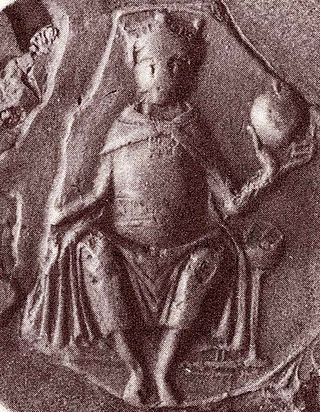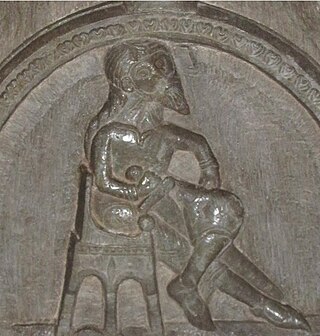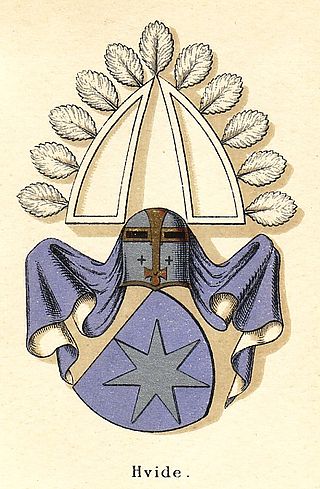Related Research Articles
Richeza of Poland, a member of the House of Piast, was twice Queen of Sweden and once Princess of Minsk through her three marriages. Tradition describes her as unusually beautiful.

Erik Knutsson, sometimes known as Eric X, was King of Sweden between 1208 and 1216. Also known as Erik the Survivor, he was, at his accession to the throne, the only remaining son of King Knut Eriksson and his queen, whose name may have been Cecilia.
Sverker the Younger, also known as Sverker II or Sverker Karlsson, was King of Sweden from 1195 or 1196 to 1208 when he was defeated in the Battle of Lena by Erik Knutsson. Sverker died in the 1210 Battle of Gestilren where his forces battled those of King Erik Knutsson.

Knut Eriksson, also known as Canute I, was King of Sweden from 1173 until his death. He was a son of King Erik the Saint and Queen Christina, who was a granddaughter of the Swedish king Inge the Elder.

Karl Sverkersson or Charles VII was the ruler of Götaland, and then King of Sweden from c. 1161 to 1167, when he was assassinated in a military attack by Knut Eriksson who then succeeded him as king.

Sverker the Elder, also known as Sverker I, was King of Sweden from about 1132 until his murder. Of non-royal descent, he founded the House of Sverker, the rulers of which alternated with the rival House of Erik over the next century.
Magnus the Strong, also known as Magnus Nilsson, was a Danish duke who ruled Götaland in southern Sweden from the 1120s to c. 1132. It is disputed whether he was elected king by the Swedes, but he is nevertheless sometimes found in the modern list of Swedish monarchs as Magnus I. Snorri Sturlason gives him the epithet "Strong".
Magnus Minniskiöld was a medieval Swedish magnate from the House of Bjälbo. He is best known as the father of the renowned statesman Birger Jarl, and the ancestor of the later Swedish kings. He is sometimes believed to have perished in the Battle of Lena in 1208, though the evidence is not conclusive.

Kol was a Swedish prince who, together with his brother Burislev was a contender for the throne of Sweden from 1167 until his violent death a few years later. The struggle was a stage in the rivalry between the House of Sverker, to which Kol and Burislev belonged, and the House of Eric.
Magnus Henriksson, also known as Magnus II, was a Danish lord and King of Sweden between 1160 and 1161. He is often seen by posterity as a usurper.
Erik Årsäll was a semi-historical king of Sweden. His historicity has been called into question. He is dated by some to the end of the 11th century, by others to the 1120s, while more critical historians believe that he is a legendary name belonging to the 10th century. According to some, he was the son of the pagan Swedish king Blót-Sweyn, and, like his father before him, administered the blóts at the temple at Uppsala. However, Erik does not appear in any Swedish or Danish primary sources.
Svantepolk Knutsson was a Swedish knight and councilor. He became a wealthy feudal lord in Östergötland.
Helena or Elin, possibly also known as Maer, Mär or Mö, was Queen of Sweden as the wife of King Inge the Elder, and a supposed sister of King Blot-Sweyn of Sweden.

Helen of Sweden was a Swedish princess and daughter of King Sverker II of Sweden. She was the mother of Queen Catherine of Sweden. She was later Abbess of Vreta Abbey.

Benedicta Hvide also called Benedicta Ebbesdotter was Queen of Sweden as the first wife of king Sverker II. She belonged to the House of Hvide of Denmark and in Sweden was often called Queen Bengta.
IngegerdBirgersdotter was Queen of Sweden as the second wife of King Sverker II.
Cecilia Johansdotter is the possible name of the wife of King Canute I of Sweden and mother of King Eric X of Sweden. Little is known about her except that she was of aristocratic origins and died sometime after 1193.
Helen, is the assumed name of a medieval Swedish princess and Danish queen, Queen consort of King Canute V of Denmark. The date of her birth is not known; her father was King Sverker I of Sweden and her mother has been assumed to be Sverker's first spouse, Queen Ulvhild.
Benedicta of Bjelbo was a Swedish noblewoman and a central figure in the incident known as the Maiden Abduction from Vreta, wherein she, like her mother, Princess Helen of Sweden before her, and her daughter, Ingrid Svantepolksdotter after her, was abducted from Vreta Abbey by the man she later married. Her abduction was the subject of the folksong "Bridal Abduction of Young Lars" .

Johan Sverkersson, who died between 1150 and 1153, was the eldest son of King Sverker the Elder of Sweden and his queen Ulfhild Håkansdotter. He had a role in the outbreak of a war between Sweden and Denmark in the 1150s.
References
- ↑ Nathanael Beckman. "Burislev". Svenskt biografiskt lexikon. Archived from the original on 12 October 2013. Retrieved 10 Oct 2013.
- ↑ Hans Gillingstam. "Jon jarl". Svenskt biografiskt lexikon. Archived from the original on 12 October 2013. Retrieved 10 Oct 2013.
- ↑ in "Från Viby till Bjälbo, studier i Sveriges historia under 100-talets senare hälft", Fornvännen 1951 p. 199
- ↑ Nils Ahnlund, "Till frågan om den äldsta Erikskulten i Sverige", Historisk tidskrift 68, 1948, p. 318.
- ↑ Lindkvist, Thomas (2021). The Västgöta Laws. London: Routledge. ISBN 978-1-003-17437-0.
- ↑ Hans Gillingstam. "Kol". Svenskt biografiskt lexikon. Archived from the original on 12 October 2013. Retrieved 10 Oct 2013.
- ↑ Adolf Schück, "Från Viby till Bjälbo, studier i Sveriges historia under 100-talets senare hälft", Fornvännen 1951 p. 212.
- ↑ Mats G. Larsson, Götarnas riken: Upptäcktsfärder till Sveriges enande. Stockholm: Atlantis, 2002, p. 185.
- ↑ Ahnlund, Nils, "Vreta klosters äldsta donatorer", Historisk tidskrift 65, 1945, p. 345.
- ↑ Hans Gillingstam, "Knut Eriksson", Svenskt biografiskt lexikon, Canute I of Sweden